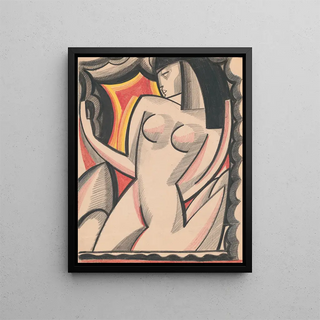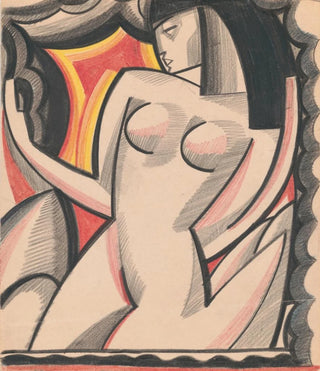Art print | Graphic design of a cubist composition drawing of a nude woman - Winold Reiss


View from behind

Frame (optional)
Graphic design reproduction of a cubist composition drawing of a nude woman - Winold Reiss – Captivating introduction
The "Graphic design of a cubist composition drawing of a nude woman" by Winold Reiss stands out as an iconic work embodying the artistic aspirations of the early 20th century. Through this piece, Reiss explores shapes and volumes, deconstructing the traditional representation of the female figure to give it a new dimension. This drawing, both bold and delicate, invites the viewer to immerse themselves in a universe where beauty blends with geometry, where every line and curve tells a story. Far from being a simple depiction, this work is an invitation to redefine our perception of nudity and aesthetics.
Style and uniqueness of the work
Winold Reiss's cubist style is distinguished by its ability to fragment and reassemble visual elements. In this work, the nude woman is depicted through geometric shapes, sharp angles, and overlapping planes. This stylistic choice creates a captivating visual dynamic, where movement and stability coexist. The color palette, subtle and nuanced, reinforces the idea of a beauty that is both raw and refined. Reiss manages to capture the essence of femininity while moving away from academic conventions, offering a representation that provokes thought and reflection. The work thus becomes a dialogue between the artist and the observer, a space where each can reinterpret the sensuality and strength of the female figure.
The artist and his influence
Winold Reiss, born in 1886 in Germany, is an artist whose work is rooted in the avant-garde currents of his time. His encounter with cubism and other contemporary artistic movements profoundly shaped his production. Reiss established himself as a pioneer in the field of representing American culture, while integrating elements of his European roots. His innovative approach influenced not only his contemporaries but also subsequent generations of artists. By exploring themes such as identity and modernity, Reiss contributed to enriching the visual language of the 20th century, making him

Matte finish

View from behind

Frame (optional)
Graphic design reproduction of a cubist composition drawing of a nude woman - Winold Reiss – Captivating introduction
The "Graphic design of a cubist composition drawing of a nude woman" by Winold Reiss stands out as an iconic work embodying the artistic aspirations of the early 20th century. Through this piece, Reiss explores shapes and volumes, deconstructing the traditional representation of the female figure to give it a new dimension. This drawing, both bold and delicate, invites the viewer to immerse themselves in a universe where beauty blends with geometry, where every line and curve tells a story. Far from being a simple depiction, this work is an invitation to redefine our perception of nudity and aesthetics.
Style and uniqueness of the work
Winold Reiss's cubist style is distinguished by its ability to fragment and reassemble visual elements. In this work, the nude woman is depicted through geometric shapes, sharp angles, and overlapping planes. This stylistic choice creates a captivating visual dynamic, where movement and stability coexist. The color palette, subtle and nuanced, reinforces the idea of a beauty that is both raw and refined. Reiss manages to capture the essence of femininity while moving away from academic conventions, offering a representation that provokes thought and reflection. The work thus becomes a dialogue between the artist and the observer, a space where each can reinterpret the sensuality and strength of the female figure.
The artist and his influence
Winold Reiss, born in 1886 in Germany, is an artist whose work is rooted in the avant-garde currents of his time. His encounter with cubism and other contemporary artistic movements profoundly shaped his production. Reiss established himself as a pioneer in the field of representing American culture, while integrating elements of his European roots. His innovative approach influenced not only his contemporaries but also subsequent generations of artists. By exploring themes such as identity and modernity, Reiss contributed to enriching the visual language of the 20th century, making him






